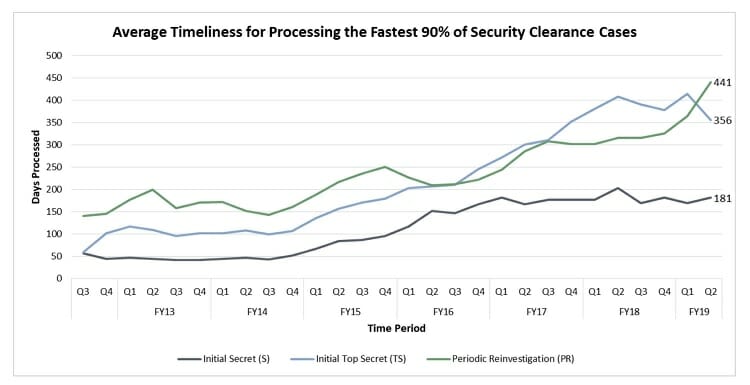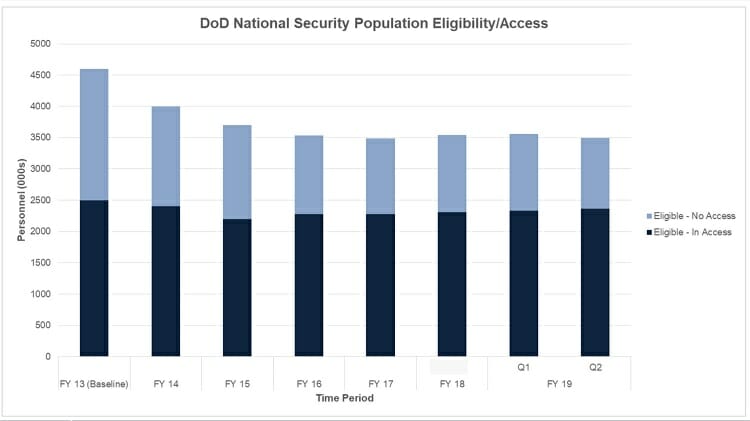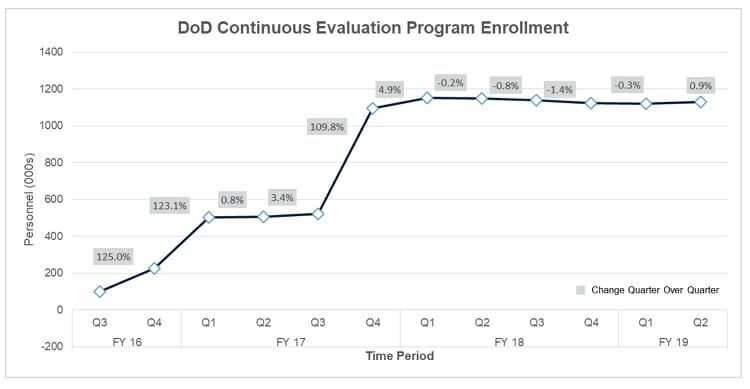The Cross Agency Priority (CAP) goals update for the second quarter notes key accomplishments toward overhauling the security clearance process made in the second quarter of 2019. Among the highlights:
- Executive Order to transfer security clearance background investigation mission from OPM to the DoD was signed, creating the Defense Counterintelligence and Security Agency to oversee personnel security.
- NBIB successfully reduced background investigations inventory by 40%, from a high of 725,000 to 433,000.
- The establishment of the Personnel Vetting Transformation Office, to oversee the transition process from OPM to DoD.
- Advancements in eAdjudication, improving automation in the personnel vetting process.
- Progress in the National Background Information System (NBIS). The IT Shared Service Rollout is designed to improve personnel vetting across the executive branch. In May, the Social Security Administration adopted the adjudication management shared service.
- Expanding Continuous Evaluation System Deployment. The system began automated record checks within the seven required continuous evaluation information categories and expanded the enrolled population.
For a government reform effort, the list makes for an impressive set of accomplishments. Like much of the security clearance process, many elements remain ‘in progress.’ Fortunately, for those with a vested interest in improving the personnel security program (which includes anyone with ties to the national security community), most of the bullets that are still in process are at least on track.
NBIB is able to end its existence on a victory lap, having accomplished its objective to reduce the backlog by an impressive 40%, getting quite near to an acceptable steady-state of pending background investigations. Officials with the Office of the Director of National Intelligence have previously stated that phase one of the reform effort is a focus on making that reduction possible. Now the focus turns to revamping the policy and updating the IT framework.
The Best Is Yet to Come
The efforts made so far only scratch the surface of the security clearance reform needed to truly created a 21st century personnel security program. That’s not to negate the work NBIB has done so far – but it does signify how heady this effort is. Critics have tried to argue the transition from OPM to DoD has been hampered by delays and hold-ups. But as anyone close to the wheels of government policy understands, the real challenge is in efforts like updating the adjudicative criteria and implementing Continuous Evaluation. Process improvement can only move the needle so far. At some point, the policy must be updated as well – and three years is often seen as a minimum for implementing something like a Security Executive Agent Directive (SEAD).
Reviewing the most recently updated CAP progress report, several things stand out.
First, security clearance processing times still aren’t exactly improving. For the fastest 90% of all cases (DoD and Intel) an initial Top Secret security clearance still takes an average of 356 days to adjudicate. As the government puts all its eggs into the CE basket, periodic reinvestigation timelines are growing even worse; 441 days for a periodic reinvestigation. Why does PR processing time matter? For many cleared professionals, the ambiguity of having a PR linger for year(s) creates issues with clearance portability and job change.
Second, the number of individuals with active or current DoD security clearances has leveled off at 3.5 million for the past two years. In the wake of Edward Snowden, a major push argued there are too many people with security clearances. The government never mentioned quotas or hit on a number, but whether it’s born out of the backlog or a changing mindset toward who requires a security clearance, DoD budgets have grown over the past two years, but the number of clearances hasn’t. Across the defense industry and national security workforce, many recruiters note poaching is literally the only way to find talent for current openings. With a tech talent shortage and lofty goals in government for improving technology, a lack of qualified, cleared talent is an issue. A decreasing number of security clearances may not be an issue – if security clearance processing times were anywhere close to the goal. As it stands, a stagnant number of active security clearances signals continued pressure on cleared recruiters.
Finally, CE, the rainbow unicorn of security clearance reform and the solution to 441-day PRs, has yet to be implemented across a broad spectrum of the security clearance population. From FY 2016-2018 each year ushered in a 100% + increase in the number of personnel enrolled in CE. For 2019, whether it’s the transition to DCSA or the need for a policy milestone in the CE program, the number of personnel enrolled remains stagnant.
The CAP progress report signals how far security clearance reform has come. But with big milestones met on the backlog, more attention needs to be focused on areas where progress has stalled – specifically, improvements in security clearance processing times and rolling out CE to the entire clearance population. Because policy must proceed process, however, these big bite reform efforts may be on track – but they’re far from finished.







